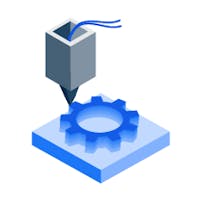PETG, which stands for polyethylene terephthalate glycol-modified, and PLA, meaning polylactic acid, are both thermoplastics, used a lot in 3D printing, also known as additive manufacturing. While we only directly offer PLA at the moment here at Xometry, knowing about both of these materials is important to help you understand what options are out there. There are good reasons why both of them are so popular. They’re compatible with most machines, can both be colored or made transparent, and they’re relatively inexpensive. This article will compare these two materials.
PETG Definition and Comparison to PLA
The “PET” in PETG is a polyester (DuPont Dacron); this was first discovered in 1931, after which it was commercialized as Terylene. The “G” is for glycol, which was added to improve the material’s thermal properties by creating a less uniform polymer chain. “The glycol added stabilizes it and lowers the melting temperature,” Christian tells us. This also lowers the residual stress from cooling. Unlike PLA, PETG is made from materials that derive from crude oil.
To learn more, see our full guide on All About PETG 3D Printing Filament.
What are the Advantages of PETG Compared to PLA?
- Very flexible
- Fairly chemically stable
- High impact strength (less likely to fracture)
- Abrasion-resistant and tough
What are the Disadvantages of PETG Compared to PLA?
- Not easy to sand
- Needs to be printed at a high temperature (could contribute to machine wear and longer cycles of warming up and cooling down)
- Highly viscous so prone to stringing (needs to be printed slower)
- More expensive than PLA and not as environmentally friendly
PLA Definition and Comparison to PETG
PLA has been around for a very long time. It dates back to the 1930s when it was initially discovered at a DuPont lab. It only became available commercially in the 1980s, though, by Cargill Inc. It’s a polymer (essentially a polyester) that’s related to PET (polyethylene terephthalate). “PLA is a bioplastic made from a variety of plant-based materials originally developed as a biodegradable plastic for single use and other applications,” says Christian Tsu-Raun, the Manual Quoting Team Lead here at Xometry. “Desirable 3D printing attributes are rigidity, low cost, and speed of printing.” The lactic acid it contains can come from pretty much anywhere suitable, including both natural and renewable sources like corn starch and sugar cane. At Xometry, we offer PLA in blue, black, white, and red, as shown in the image below:
To learn more, see our full guide on All About PLA 3D Printing Filament.

What are the Advantages of PLA Compared to PETG?
- Makes parts with great cosmetic quality with FDM (fused deposition modeling) printers
- Ease to post-process and hand-finish prints
- Keeps part accuracy as it has a low chance of warping
- Affordable
- Low viscosity at the nozzle
- Low melting point
- Cools to a hard and durable finish
- Good for hobbyists as well as professionals
What are the Disadvantages of PLA Compared to PETG?
- Parts are more susceptible to moisture and UV
- Less temperature stable than other options
- Not the strongest material (could fracture when bent or twisted)
- It’s anisotropic as its interior layers don’t bond as well as other materials

Download Our FREE FDM Design Guide
| Attribute | PETG | PLA |
|---|---|---|
Attribute Typical Tensile Strength (Yield) | PETG 50 MPa | PLA 57.4 MPa |
Attribute Typical Elongation at Break % | PETG ~130% | PLA 1.9%-4% |
Attribute Cosmetic Quality | PETG Fair | PLA Excellent |
Attribute Tendency to String or Ooze | PETG High | PLA Low |
Attribute Typical Cost per Kilogram | PETG $15–$25 per kg | PLA $12–$20 per kg |
Attribute Easy to Post-Process/Sand | PETG No | PLA Yes |
Attribute Applications | PETG Good for parts that need to be exposed to chemicals, wear, contact with other components, water, sun, and heat | PLA Low-stress cosmetic use and parts that require a better finish quality |
Attribute Printing Speed | PETG Slower, with longer warm-up and cool-down times | PLA Faster |
Attribute Melting Point | PETG Between 220°C and 250°C | PLA Between 180°C and 210°C |
PETG vs. PLA Comparison Note: The values in this table are for reference only and are based on data from various providers. For more specific information, we recommend checking manufacturer-provided data sheets.
Model strength and resilience are considerably higher for PETG. The cosmetic quality of model surfaces, however, is generally better for PLA.
PETG vs. PLA: Applications Comparison
PETG is better for strength, wear resistance, and chemical resistance. Stressed components and moving parts are better made in PETG. Model parts in moving contact against other components will be more resilient in PETG. Parts that will experience either water, sunlight, or heat exposure will also be better in PETG. PLA is better suited to low-stress, cosmetic applications, and components that require a better finish.
PETG vs. PLA: Part Accuracy Comparison
PLA is better suited to maintaining part precision. This is because of its better printability and lower warping. It should be noted, however, that under steady load, PLA tends to creep. For smaller features, PETG bonds better, as it is more viscous in the melt state and achieves better intra-layer coupling.
PETG vs. PLA: Speed Comparison
PETG is more sensitive to print speed than PLA. Newly extruded material may not stick to the layer below or the last strands if the print speed is high. PLA is more sticky, due to its lower viscosity. This results in PETG model build speeds being lower than PLA.
PETG vs. PLA: Surface Comparison
Both materials produce similar surface finish quality. Although in many cases PLA models look smoother because of the lower melt viscosity.
PETG vs. PLA: Heat Resistance Comparison
PETG has a considerably higher melting point than PLA (180°C for PETG, 165°C for PLA).
PETG vs. PLA: Biodegradability Comparison
PETG is derived from crude oil and is environmentally stable. Its life in landfills is measured in centuries. It does experience some degree of UV degradation, shortening the breakdown. PLA is a fragile polymer, and its environmental resistance is so short that it can influence the shelf life of the packaged product.
PETG vs. PLA: Toxicity Comparison
PETG and PLA meet the GRAS (Generally Recognized As Safe) standard and are food safe. Two considerations may influence the application of FDM/FFF parts in food safety terms:
- Depolymerization occurs when plastics are overheated, producing non-food-safe results. This is more likely to occur in the case of PLA, as the polymer chains are more prone to scorching during extrusion.
- Coloring agents used in the polymers are likely to NOT be food-safe – and PLA may allow these dye agents to leak.
These factors do NOT imply that printed parts are not food safe. But care should be taken to minimize the use of FDM and FFF parts in food contact.
PETG vs. PLA: Cost Comparison
PETG has a typical cost range of $20 to $25 per kg. This depends on the material class, supplier, and volume purchased. Standard PLA, on the other hand, costs around $15 to $20 per kg.
What are the Mutual Alternatives to PETG and PLA?
Below are the mutual alternatives to both PETG and PLA:
- ABS: Acrylonitrile butadiene styrene (ABS) is a popular alternative to both PETG and PLA. It can produce good quality, high-strength models. Although, there's a risk of warping and strong smell, requiring tight control of settings. ABS is also much harder to use than either PETG or PLA.
- ASA: Acrylonitrile styrene acrylate (ASA) is related to ABS, except that it has greater UV resistance, making it ideal for outdoor uses. ASA suffers the same setup and printing issues as ABS and they are both considered good alternatives to both PETG and PLA.
- PC: Polycarbonate (PC) is also an alternative to PETG and PLA. It has high clarity but requires high-temperature extrusion, limiting its application.
What are the Similarities Between PETG and PLA?
PETG and PLA do have similarities that are significant:
- Their extrusion temperatures are within 15°C of each other, making them interchangeable on most machines.
- They can both be transparent or colored.
- They are the low-cost materials of choice for the majority of FDM/FFF modeling.
Frequently Asked Questions on PETG and PLA
What are the Other Comparisons for PETG Besides PLA?
One not very commonly available material directly compares with PETG:
- PETG vs PCTG: PCTG (Polycyclohexylenedimethylene terephthalate) is considered a good alternative to PETG. It offers higher bonds, tensile strength, and clarity. PCTG, however, has a 250–270°C nozzle temperature, which is out of reach for some printers. Interestingly, PCTG is able to print matte or gloss depending on extruder temperature.
What are the Other Comparisons for PLA Besides PETG?
The material that most closely compares with PLA is enhanced PLA (or PLA+):
- PLA vs. PLA+: PLA+ is a family of easy-to-print materials with enhanced properties compared to PLA. It is made from PLA with a range of additives. Examples of additives are: calcium carbonate to improve tensile strength, carbon fibers to enhance flexural strength, metal flakes to make metallic-looking prints, and nucleating agents to enhance layer bonding.
This is a wide family of materials whose costs reflect the complexity of manufacture and enhanced performance.
How Xometry Can Help
Still have questions about PETG or PLA? Then reach out to one of our representatives. We also offer lots of manufacturing services including CNC machining, laser cutting, and, of course, 3D printing. You can quickly and easily upload your designs to our website and get your free, no-obligation quote today.
Disclaimer
The content appearing on this webpage is for informational purposes only. Xometry makes no representation or warranty of any kind, be it expressed or implied, as to the accuracy, completeness, or validity of the information. Any performance parameters, geometric tolerances, specific design features, quality and types of materials, or processes should not be inferred to represent what will be delivered by third-party suppliers or manufacturers through Xometry’s network. Buyers seeking quotes for parts are responsible for defining the specific requirements for those parts. Please refer to our terms and conditions for more information.


